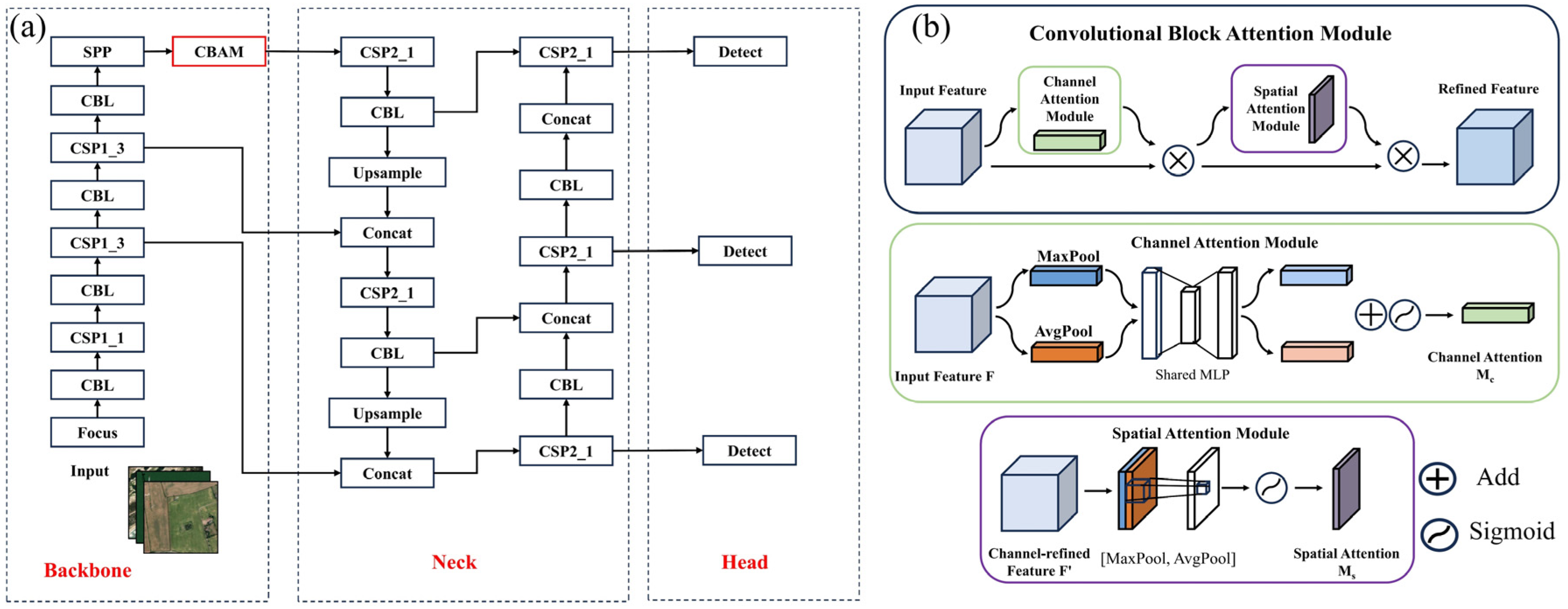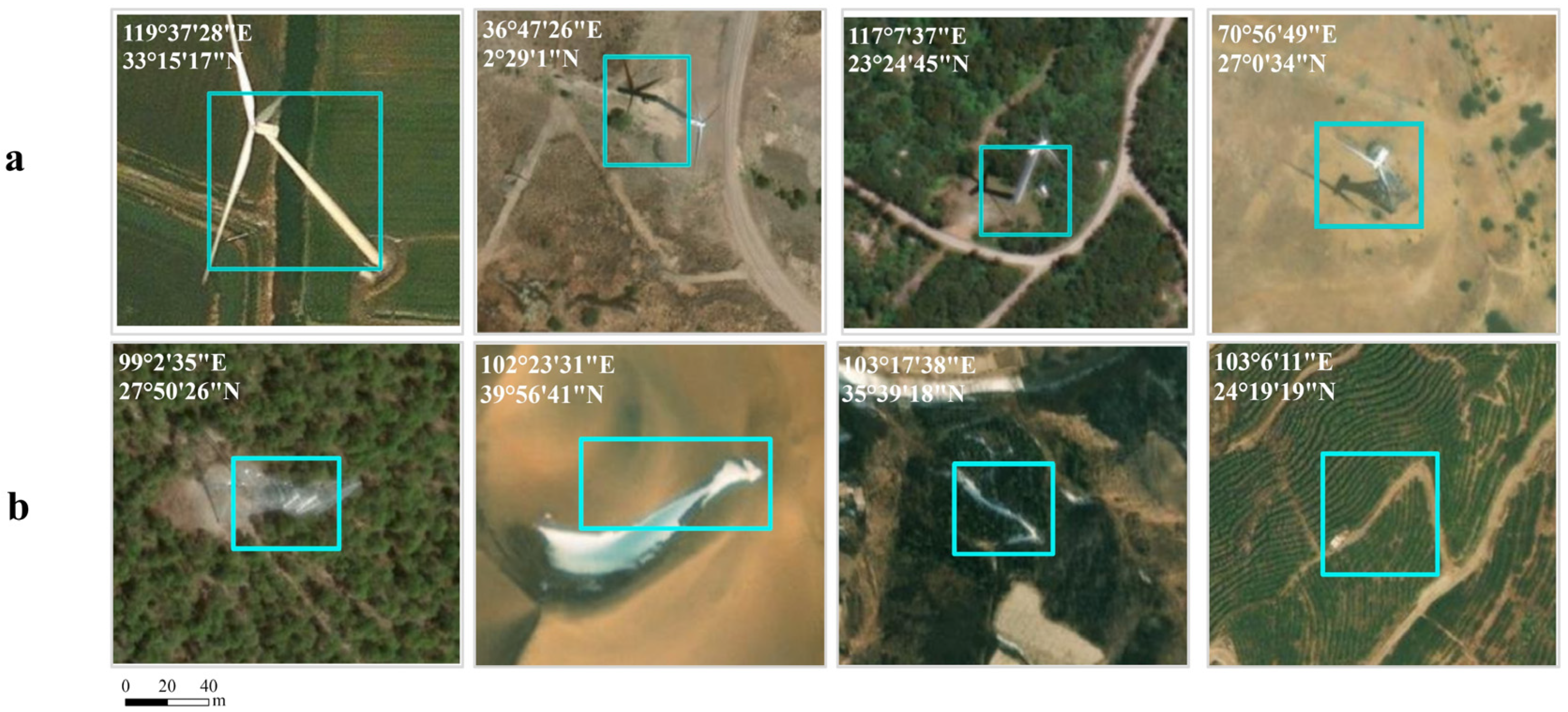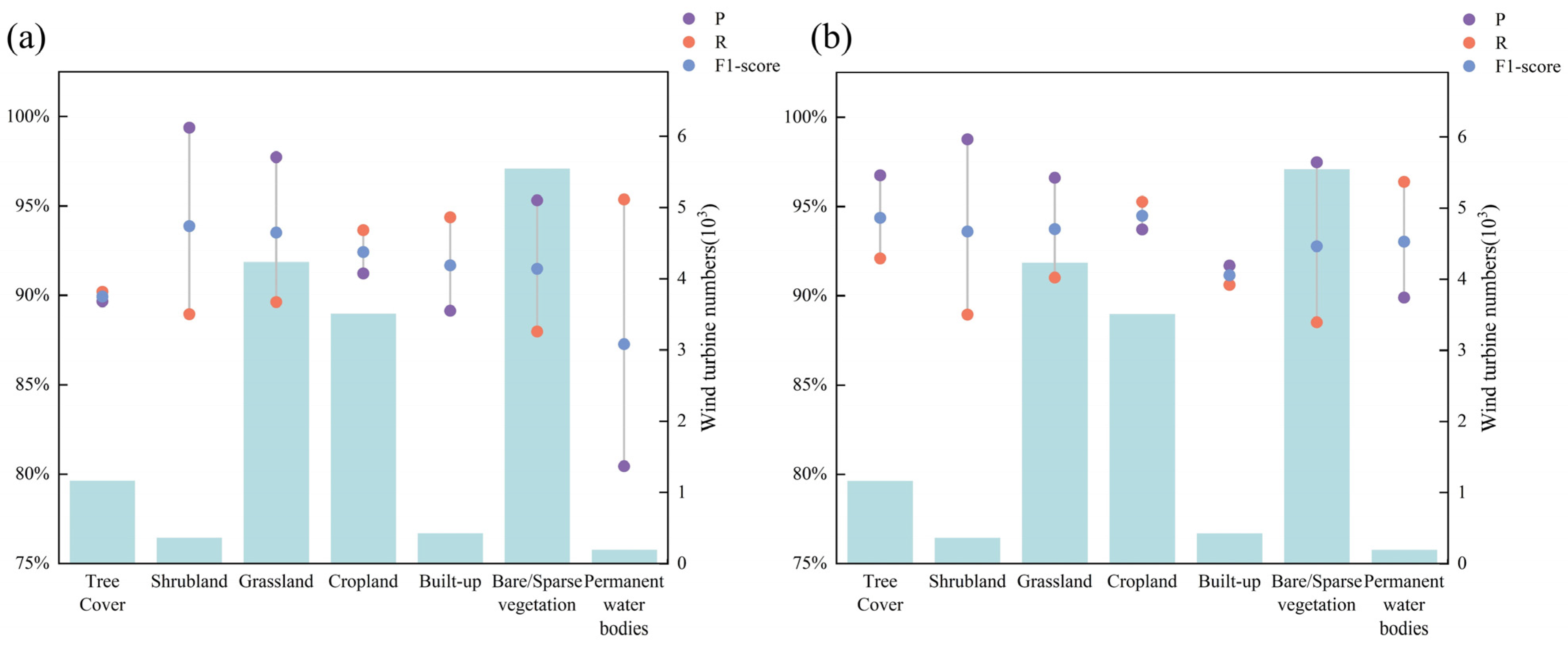YOLOv5_CDB: A Global Wind Turbine Detection Framework Integrating CBAM and DBSCAN
Abstract
1. Introduction
2. Methodology
2.1. YOLOv5_CDB Algorithm
2.1.1. CBAM Optimization for Feature Enhancement of Multi-Scale Targets
2.1.2. DBSCAN Optimization for Dense Object Detection
2.2. Technical Workflow for Wind Turbine Detection
2.2.1. Dataset Selection for Sample Labeling
2.2.2. Sample Creation Process
2.2.3. Model Training
2.2.4. Detection Accuracy Evaluation
3. Global Experiments
3.1. Test Areas
3.2. Experimental Image
3.3. Detection Performance of Model
3.3.1. Model Performance at Optimal Confidence Levels
3.3.2. Model Performance Across Land Cover Classes
4. Discussion
4.1. Model Performance Comparative Analysis
4.2. Analysis of Detection Errors
4.2.1. Missed Detection and Contributing Factors
4.2.2. False Detection and Contributing Factors
4.3. Advantages, Limitations, and Future Research
5. Conclusions
Author Contributions
Funding
Institutional Review Board Statement
Informed Consent Statement
Data Availability Statement
Conflicts of Interest
References
- Wang, D.; Huangfu, Y.; Dong, Z.; Dong, Y. Research Hotspots and Evolution Trends of Carbon Neutrality—Visual Analysis of Bibliometrics Based on CiteSpace. Sustainability 2022, 14, 1078. [Google Scholar] [CrossRef]
- Zheng, C.W.; Li, C.Y.; Pan, J.; Liu, M.Y.; Xia, L.L. An overview of global ocean wind energy resource evaluations. Renew. Sust. Energy Rev. 2016, 53, 1240–1251. [Google Scholar]
- Zheng, C.W.; Li, C.Y. Variation of the wave energy and significant wave height in the China Sea and adjacent waters. Renew. Sust. Energy Rev. 2015, 43, 381–387. [Google Scholar]
- Roga, S.; Bardhan, S.; Kumar, Y.; Dubey, S.K. Recent technology and challenges of wind energy generation: A review. Sustain. Energy Technol. Assess. 2022, 52, 102239. [Google Scholar] [CrossRef]
- Global Wind Energy Concil (GWEC). Global Wind Report 2024. Available online: https://www.gwec.net/reports/globalwindreport (accessed on 22 December 2024).
- Bashir, M.B.A. Principle Parameters and Environmental Impacts that Affect the Performance of Wind Turbine: An Overview. Arab. J. Sci. Eng. 2022, 47, 7891–7909. [Google Scholar]
- Bansal, J.C.; Farswan, P. Wind farm layout using biogeography based optimization. Renew. Energy 2017, 107, 386–402. [Google Scholar] [CrossRef]
- Kusiak, A.; Song, Z. Design of wind farm layout for maximum wind energy capture. Renew. Energy 2010, 35, 685–694. [Google Scholar]
- Chang, S.; Deng, Y.; Zhang, Y.; Zhao, Q.; Wang, R.; Zhang, K. An Advanced Scheme for Range Ambiguity Suppression of Spaceborne SAR Based on Blind Source Separation. IEEE Trans. Geosci. Remote Sens. 2022, 60, 5230112. [Google Scholar] [CrossRef]
- Wong, B.A.; Thomas, C.; Halpin, P. Automating offshore infrastructure extractions using synthetic aperture radar & Google Earth Engine. Remote Sens. Environ. 2019, 233, 111412. [Google Scholar]
- Hoeser, T.; Feuerstein, S.; Kuenzer, C. DeepOWT: A global offshore wind turbine data set derived with deep learning from Sentinel-1 data. Earth Syst. Sci. Data 2022, 14, 4251–4270. [Google Scholar]
- Zhang, T.; Tian, B.; Sengupta, D.; Zhang, L.; Si, Y. Global offshore wind turbine dataset. Sci. Data 2021, 8, 191. [Google Scholar] [PubMed]
- Xu, W.; Liu, Y.; Wu, W.; Dong, Y.; Lu, W.; Liu, Y.; Zhao, B.; Li, H.; Yang, R. Proliferation of offshore wind farms in the North Sea and surrounding waters revealed by satellite image time series. Renew. Sustain. Energy Rev. 2020, 133, 110167. [Google Scholar]
- Wang, K.; Xiao, W.; He, T.; Zhang, M. Remote sensing unveils the explosive growth of global offshore wind turbines. Renew. Sustain. Energy Rev. 2024, 191, 114186. [Google Scholar]
- Wang, F.; Zhang, S.; Hou, Y.; Wang, J. Extraction of offshore wind turbines in China by combining multispectral and SAR image data. IEEE J. Sel. Top. Appl. Earth Obs. Remote Sens. 2024, 17, 9266–9281. [Google Scholar]
- Mandroux, N.; Dagobert, T.; Drouyer, S.; Grompone von Gioi, R. Single date wind turbine detection on Sentinel-2 optical images. Image Process. Line 2022, 12, 198–217. [Google Scholar]
- Mandroux, N.; Drouyer, S.; Grompone von Gioi, R. Multi-date wind turbine detection on optical satellite images. ISPRS Ann. Photogramm. Remote Sens. Spat. Inf. Sci. 2022, V-2-2022, 383–390. [Google Scholar]
- Yue, A.; Chen, J. Wind turbine extraction from high spatial resolution remote sensing images based on saliency detection. J. Appl. Remote Sens. 2018, 12, 016041. [Google Scholar]
- Li, H.; Zhao, J.; Zhang, Y.; Zhang, Y. Recognition of windmills in remote sensingimage by SVM and morphological attribute filters. In Proceedings of the IGARSS 2018—2018 IEEE International Geoscience and Remote Sensing Symposium, Valencia, Spain, 22–27 July 2018; pp. 6923–6926. [Google Scholar]
- Xu, Z.; Zhang, H.; Wang, Y.; Wang, X.; Xue, S.; Liu, W. Dynamic detection of offshore wind turbines by spatial machine learning from spaceborne synthetic aperture radar imagery. J. King Saud Univ.—Comput. Inf. Sci. 2022, 34, 1674–1686. [Google Scholar]
- Zhang, S.; Wang, F.; Hou, Y.; Wang, J.; Guo, J. Global offshore wind turbine detection: A combined application of deep learning and Google earth engine. Int. J. Remote Sens. 2024, 45, 6601–6623. [Google Scholar]
- Chen, J.; Chen, J.; Meng, Y.; Deng, Y.; Jie, Y.; Zhang, Y. Detection of wind turbine towers in remote sensing based on YOLOv3 model under scale and density constraints. Remote Sens. Nat. Resour. 2021, 33, 54–62. [Google Scholar]
- Chen, D.; Cheng, T.; Lu, Y.; Xiao, J.; Ji, C.; Hong, S.; Zhuang, Q.; Cheng, L. A method for fast detection of wind farms from remote sensing images using deep learning and geospatial analysis. Open Geosci. 2024, 16, 20220645. [Google Scholar] [CrossRef]
- Zhai, Y.; Chen, X.; Cao, X.; Cui, X. Identifying wind turbines from multiresolution and multibackground remote sensing imagery. Int. J. Appl. Earth Obs. Geoinf. 2024, 126, 103613. [Google Scholar] [CrossRef]
- Zhang, W.; Wang, G.; Qi, J.; Wang, G.; Zhang, T. Research on the extraction of wind turbine all over the China based on domestic satellite remote sensing data. In Proceedings of the 2021 IEEE International Geoscience and Remote Sensing Symposium IGARSS, Brussels, Belgium, 11–16 July 2021; pp. 4167–4170. [Google Scholar]
- Qiang, H.; Hao, W.; Xie, M.; Tang, Q.; Shi, H.; Zhao, Y.; Han, X. SCM-YOLO for Lightweight Small Object Detection in Remote Sensing Images. Remote Sens. 2025, 17, 249. [Google Scholar] [CrossRef]
- Qiu, Y.; Xue, J.; Zhang, G.; Hao, X.; Lei, T.; Jiang, P. RS-FeatFuseNet: An Integrated Remote Sensing Object Detection Model with Enhanced Feature Extraction. Remote Sens. 2025, 17, 61. [Google Scholar] [CrossRef]
- Wan, Y.; Zhan, Z.; Ren, P.; Fan, L.; Liu, Y.; Li, L.; Dai, Y. Storage Tank Target Detection for Large-Scale Remote Sensing Images Based on YOLOv7-OT. Remote Sens. 2024, 16, 4510. [Google Scholar] [CrossRef]
- Zhao, J.; Zhang, X.; Yan, J.; Qiu, X.; Yao, X.; Tian, Y.; Zhu, Y.; Cao, W. A Wheat Spike Detection Method in UAV Images Based on Improved YOLOv5. Remote Sens. 2021, 13, 3095. [Google Scholar] [CrossRef]
- Gallo, I.; Rehman, A.U.; Dehkordi, R.H.; Landro, N.; La Grassa, R.; Boschetti, M. Deep Object Detection of Crop Weeds: Performance of YOLOv7 on a Real Case Dataset from UAV Images. Remote Sens. 2023, 15, 539. [Google Scholar] [CrossRef]
- Chen, Z.; Liu, C.; Filaretov, V.F.; Yukhimets, D.A. Multi-Scale Ship Detection Algorithm Based on YOLOv7 for Complex Scene SAR Images. Remote Sens. 2023, 15, 2071. [Google Scholar] [CrossRef]
- Gong, H.; Mu, T.; Li, Q.; Dai, H.; Li, C.; He, Z.; Wang, W.; Han, F.; Tuniyazi, A.; Li, H.; et al. Swin-Transformer-Enabled YOLOv5 with Attention Mechanism for Small Object Detection on Satellite Images. Remote Sens. 2022, 14, 2861. [Google Scholar] [CrossRef]
- Xu, X.; Zhang, X.; Zhang, T. Lite-YOLOv5: A Lightweight Deep Learning Detector for On-Board Ship Detection in Large-Scene Sentinel-1 SAR Images. Remote Sens. 2022, 14, 1018. [Google Scholar] [CrossRef]
- Liu, C.; Sui, H.; Wang, J.; Ni, Z.; Ge, L. Real-Time Ground-Level Building Damage Detection Based on Lightweight and Accurate YOLOv5 Using Terrestrial Images. Remote Sens. 2022, 14, 2763. [Google Scholar] [CrossRef]
- He, C.; Liu, Y.; Wang, D.; Liu, S.; Yu, L.; Ren, Y. Automatic Extraction of Bare Soil Land from High-Resolution Remote Sensing Images Based on Semantic Segmentation with Deep Learning. Remote Sens. 2023, 15, 1646. [Google Scholar] [CrossRef]
- Dong, X.; Yan, S.; Duan, C. A lightweight vehicles detection network model based on YOLOv5. Eng. Appl. Artif. Intell. 2022, 113, 104914. [Google Scholar]
- Zhu, L.; Geng, X.; Li, Z.; Liu, C. Improving YOLOv5 with Attention Mechanism for Detecting Boulders from Planetary Images. Remote Sens. 2021, 13, 3776. [Google Scholar] [CrossRef]
- Woo, S.; Park, J.; Lee, J.-Y.; Kweon, I.S. CBAM: Convolutional Block Attention Module. In Proceedings of the Computer Vision—ECCV 2018, Munich, Germany, 8–14 September 2018; Springer: Cham, Switzerland, 2018; pp. 3–19. [Google Scholar]
- Zhang, X.; Zhou, S. WOA-DBSCAN: Application of Whale Optimization Algorithm in DBSCAN parameter adaption. IEEE Access 2023, 11, 91861–91878. [Google Scholar]
- Hebbal, A.; Balesdent, M.; Brevault, L.; Melab, N.; Talbi, E.-G. Deep Gaussian process for multi-objective Bayesian optimization. Optim. Eng. 2023, 24, 1809–1848. [Google Scholar]
- Dunnett, S.; Sorichetta, A.; Taylor, G.; Eigenbrod, F. Harmonised global datasets of wind and solar farm locations and power. Sci. Data 2020, 7, 130. [Google Scholar]
- Hoen, B.D.; Diffendorfer, J.E.; Rand, J.T.; Kramer, L.A.; Garrity, C.P.; Hunt, H.E. United States Wind Turbine Database V7.2: U.S. Geological Survey, American Clean Power Association, and Lawrence Berkeley National Laboratory Data Release. 2018. Available online: https://energy.usgs.gov/uswtdb/data/ (accessed on 23 December 2024).
- Zhang, X.; Han, L.; Han, L.; Zhu, L. How well do deep learning-based methods for land cover classification and object detection perform on high resolution remote sensing imagery? Remote Sens. 2020, 12, 417. [Google Scholar] [CrossRef]






| Models | Input Size | Batch Size | Epochs | Learning Rate | Momentum/β1 | Weight Decay | Optimizer | Other |
|---|---|---|---|---|---|---|---|---|
| YOLOv5s | 640 × 640 | 16 | 300 | 0.01 | 0.937 | 0.0005 | SGD | |
| YOLOv5_CDB | 640 × 640 | 16 | 300 | 0.01 | 0.937 | 0.0005 | SGD | = 1796, Minpts = 3 |
| YOLOv8s | 640 × 640 | 16 | 300 | 0.01 | 0.9 | 0.01 | AdamW | |
| YOLOv12s | 640 × 640 | 16 | 300 | 0.01 | 0.937 | 0.0005 | SGD | |
| RT-DETR | 640 × 640 | 16 | 300 | 0.01 | 0.937 | 0.0005 | SGD |
| Confidence | YOLOv5s | YOLOv5_CDB | ||||||
|---|---|---|---|---|---|---|---|---|
| P (%) | R (%) | F1-Score (%) | mAP@0.5 | P (%) | R (%) | F1-Score (%) | mAP@0.5 | |
| 0.25 | 85.52 | 93.51 | 89.34 | 0.926 | 92.84 | 92.69 | 92.76 | 0.926 |
| 0.35 | 89.28 | 92.61 | 90.91 | 0.918 | 94.73 | 91.97 | 93.33 | 0.918 |
| 0.45 | 92.07 | 91.70 | 91.89 | 0.910 | 95.97 | 91.18 | 93.51 | 0.911 |
| 0.55 | 94.14 | 90.19 | 92.12 | 0.896 | 96.92 | 90.11 | 93.39 | 0.900 |
| 0.65 | 96.24 | 88.17 | 92.03 | 0.878 | 97.81 | 88.30 | 92.81 | 0.882 |
| 0.75 | 98.01 | 83.37 | 90.10 | 0.831 | 98.79 | 84.79 | 91.26 | 0.847 |
| 0.85 | 99.81 | 65.87 | 79.37 | 0.658 | 99.78 | 71.85 | 83.54 | 0.718 |
| Confidence | YOLOv5_CDB | YOLOv8s | YOLOv12s | RT-DETR | ||||||||||||
|---|---|---|---|---|---|---|---|---|---|---|---|---|---|---|---|---|
| P (%) | R (%) | F1-Score (%) | mAP@0.5 | P (%) | R (%) | F1-Score (%) | mAP@0.5 | P (%) | R (%) | F1-Score (%) | mAP@0.5 | P (%) | R (%) | F1-Score (%) | mAP@0.5 | |
| 0.25 | 92.84 | 92.69 | 92.76 | 0.926 | 92.11 | 90.40 | 91.24 | 0.884 | 79.73 | 94.64 | 86.55 | 0.899 | 79.06 | 96.15 | 86.77 | 0.931 |
| 0.35 | 94.73 | 91.97 | 93.33 | 0.918 | 94.20 | 89.26 | 91.67 | 0.874 | 85.16 | 92.02 | 88.46 | 0.883 | 88.86 | 92.57 | 90.68 | 0.903 |
| 0.45 | 95.97 | 91.18 | 93.51 | 0.911 | 95.80 | 87.82 | 91.64 | 0.862 | 89.57 | 89.48 | 89.53 | 0.866 | 93.54 | 90.01 | 91.74 | 0.881 |
| 0.55 | 96.92 | 90.11 | 93.39 | 0.900 | 96.78 | 85.99 | 91.07 | 0.847 | 92.72 | 86.23 | 89.36 | 0.841 | 96.36 | 86.77 | 91.31 | 0.852 |
| 0.65 | 97.81 | 88.30 | 92.81 | 0.882 | 97.61 | 83.41 | 89.95 | 0.824 | 96.13 | 81.15 | 88.01 | 0.798 | 98.32 | 81.25 | 88.97 | 0.801 |
| 0.75 | 98.79 | 84.79 | 91.26 | 0.847 | 98.60 | 78.74 | 87.56 | 0.781 | 99.17 | 66.07 | 79.31 | 0.657 | 99.69 | 58.70 | 73.90 | 0.583 |
| 0.85 | 99.78 | 71.85 | 83.54 | 0.718 | 99.77 | 56.13 | 71.84 | 0.561 | 100 | 0.61 | 1.22 | 0.007 | 100 | 0.01 | 0.01 | 0.001 |
| Model | Layout | TP + FN | P | R |
|---|---|---|---|---|
| YOLOv5s | Regular (uniform size) | 742 | 98.6% | 96.76% |
| Regular (varying size) | 750 | 99.8% | 67.06% | |
| Mixed | 799 | 94.7% | 94.1% | |
| YOLOv5_CDB | Regular (uniform size) | 742 | 99.3% | 98.11% |
| Regular (varying size) | 750 | 99.8% | 75.87% | |
| Mixed | 799 | 96.7% | 95.1% |
| Category | Error Count | Percentage (%) |
|---|---|---|
| Field ridge | 153 | 25.84 |
| Snow-covered area | 31 | 5.24 |
| Salinized land | 16 | 2.70 |
| Transmission tower | 184 | 31.08 |
| Building shadow | 110 | 18.58 |
| Abandoned or dismantled wind turbine | 5 | 0.84 |
| Other | 93 | 15.71 |
Disclaimer/Publisher’s Note: The statements, opinions and data contained in all publications are solely those of the individual author(s) and contributor(s) and not of MDPI and/or the editor(s). MDPI and/or the editor(s) disclaim responsibility for any injury to people or property resulting from any ideas, methods, instructions or products referred to in the content. |
© 2025 by the authors. Licensee MDPI, Basel, Switzerland. This article is an open access article distributed under the terms and conditions of the Creative Commons Attribution (CC BY) license (https://creativecommons.org/licenses/by/4.0/).
Share and Cite
Fei, Y.; Gao, Y.; Gu, H.; Sun, Y.; Tian, Y. YOLOv5_CDB: A Global Wind Turbine Detection Framework Integrating CBAM and DBSCAN. Remote Sens. 2025, 17, 1322. https://doi.org/10.3390/rs17081322
Fei Y, Gao Y, Gu H, Sun Y, Tian Y. YOLOv5_CDB: A Global Wind Turbine Detection Framework Integrating CBAM and DBSCAN. Remote Sensing. 2025; 17(8):1322. https://doi.org/10.3390/rs17081322
Chicago/Turabian StyleFei, Yasen, Yongnian Gao, Hongyuan Gu, Yongqi Sun, and Yanjun Tian. 2025. "YOLOv5_CDB: A Global Wind Turbine Detection Framework Integrating CBAM and DBSCAN" Remote Sensing 17, no. 8: 1322. https://doi.org/10.3390/rs17081322
APA StyleFei, Y., Gao, Y., Gu, H., Sun, Y., & Tian, Y. (2025). YOLOv5_CDB: A Global Wind Turbine Detection Framework Integrating CBAM and DBSCAN. Remote Sensing, 17(8), 1322. https://doi.org/10.3390/rs17081322







